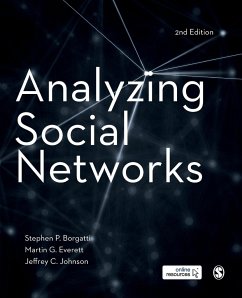Schade – dieser Artikel ist leider ausverkauft. Sobald wir wissen, ob und wann der Artikel wieder verfügbar ist, informieren wir Sie an dieser Stelle.
- Broschiertes Buch
- Merkliste
- Auf die Merkliste
- Bewerten Bewerten
- Teilen
- Produkt teilen
- Produkterinnerung
- Produkterinnerung
The leading guidebook for social network students and researchers, particularly those using NetDraw and UCINET data analysis software, now with updated tools, methods and statistical models.
Andere Kunden interessierten sich auch für
![Analyzing New Forms of Social Disorders in Modern Virtual Environments Analyzing New Forms of Social Disorders in Modern Virtual Environments]() Analyzing New Forms of Social Disorders in Modern Virtual Environments237,99 €
Analyzing New Forms of Social Disorders in Modern Virtual Environments237,99 €![Analyzing Student Performance Prediction: Meta Stacking Classification Analyzing Student Performance Prediction: Meta Stacking Classification]() Smita PallaviAnalyzing Student Performance Prediction: Meta Stacking Classification34,99 €
Smita PallaviAnalyzing Student Performance Prediction: Meta Stacking Classification34,99 €![A FRAMEWORK FOR ANALYZING THE TARGETING OF SOCIAL POLICIES IN COLOMBIA A FRAMEWORK FOR ANALYZING THE TARGETING OF SOCIAL POLICIES IN COLOMBIA]() Edgar Prieto CorredorA FRAMEWORK FOR ANALYZING THE TARGETING OF SOCIAL POLICIES IN COLOMBIA33,99 €
Edgar Prieto CorredorA FRAMEWORK FOR ANALYZING THE TARGETING OF SOCIAL POLICIES IN COLOMBIA33,99 €![Analyzing New Forms of Social Disorders in Modern Virtual Environments Analyzing New Forms of Social Disorders in Modern Virtual Environments]() Analyzing New Forms of Social Disorders in Modern Virtual Environments178,99 €
Analyzing New Forms of Social Disorders in Modern Virtual Environments178,99 €![Encyclopedia of Social Networks Encyclopedia of Social Networks]() Encyclopedia of Social Networks518,99 €
Encyclopedia of Social Networks518,99 €![What value does Marxism have in analyzing contemporary inequality? What value does Marxism have in analyzing contemporary inequality?]() Kaia SmithWhat value does Marxism have in analyzing contemporary inequality?9,99 €
Kaia SmithWhat value does Marxism have in analyzing contemporary inequality?9,99 €![Analyzing Inequality Analyzing Inequality]() Analyzing Inequality110,99 €
Analyzing Inequality110,99 €-
-
The leading guidebook for social network students and researchers, particularly those using NetDraw and UCINET data analysis software, now with updated tools, methods and statistical models.
Produktdetails
- Produktdetails
- Verlag: Sage Publications
- 2nd ed.
- Seitenzahl: 384
- Erscheinungstermin: 19. Januar 2018
- Englisch
- Abmessung: 235mm x 191mm x 21mm
- Gewicht: 712g
- ISBN-13: 9781526404107
- ISBN-10: 1526404109
- Artikelnr.: 49471595
- Herstellerkennzeichnung
- Books on Demand GmbH
- In de Tarpen 42
- 22848 Norderstedt
- info@bod.de
- 040 53433511
- Verlag: Sage Publications
- 2nd ed.
- Seitenzahl: 384
- Erscheinungstermin: 19. Januar 2018
- Englisch
- Abmessung: 235mm x 191mm x 21mm
- Gewicht: 712g
- ISBN-13: 9781526404107
- ISBN-10: 1526404109
- Artikelnr.: 49471595
- Herstellerkennzeichnung
- Books on Demand GmbH
- In de Tarpen 42
- 22848 Norderstedt
- info@bod.de
- 040 53433511
Stephen P. Borgatti, PhD is the Gatton Endowed Chair of Management at the Gatton College of Business and Economics at the University of Kentucky. He has published extensively in management journals, as well as cross-disciplinary journals such as Science and Social Networks. He has published over 100 peer-reviewed articles on network analysis, garnering more than 80,000 Google Scholar citations. With Martin Everett, Steve is co-author of UCINET, a well-known software package for social network analysis, as well as founder of the annual LINKS Center workshop on social network analysis. He is also a two-term past president of INSNA (the professional association for network researchers) and winner of their Simmel Award for lifetime achievement.
Chapter 1: Introduction
Why networks?
What are networks?
Types of relations
Goals of analysis
Network variables as explanatory variables
Network variables as outcome variables
Chapter 2: Mathematical Foundations
Graphs
Paths and components
Adjacency matrices
Ways and modes
Matrix products
Chapter 3: Research Design
Experiments and field studies
Whole-network and personal-network research designs
Sources of network data
Types of nodes and types of ties
Actor attributes
Sampling and bounding
Sources of data reliability and validity issues
Ethical considerations
Chapter 4: Data Collection
Network questions
Question formats
Interviewee burden
Data collection and reliability
Archival data collection
Data from electronic sources
Chapter 5: Data Management
Data import
Cleaning network data
Data transformation
Normalization
Cognitive social structure data
Matching attributes and networks
Converting attributes to matrices
Data export
Chapter 6: Multivariate Techniques Used in Network Analysis
Multidimensional scaling
Correspondence analysis
Hierarchical clustering
Chapter 7: Visualization
Layout
Embedding node attributes
Node filtering
Ego networks
Embedding tie characteristics
Visualizing network change
Exporting visualizations
Closing comments
Chapter 8: Testing Hypotheses
Permutation tests
Dyadic hypotheses
Mixed dyadic-monadic hypotheses
Node level hypotheses
Whole-network hypotheses
Exponential random graph models
Stochastic actor-oriented models (SAOMs)
Chapter 9: Characterizing Whole Networks
Cohesion
Reciprocity
Transitivity and the clustering coefficient
Triad census
Centralization and core-periphery indices
Chapter 10: Centrality
Basic concept
Undirected, non-valued networks
Directed, non-valued networks
Valued networks
Negative tie networks
Chapter 11: Subgroups
Cliques
Girvan-Newman algorithm
Factions and modularity optimization
Directed and valued data
Computational considerations
Performing a cohesive subgraph analysis
Supplementary material
Chapter 12: Equivalence
Structural equivalence
Profile similarity
Blockmodels
The direct method
Regular equivalence
The REGE algorithm
Core-periphery models
Chapter 13: Analyzing Two-mode Data
Converting to one-mode data
Converting valued two-mode matrices to one-mode
Bipartite networks
Cohesive subgroups and community detection
Core-periphery models
Equivalence
Chapter 14: Large Networks
Reducing the size of the problem
Choosing appropriate methods
Sampling
Small-world and scale-free networks
Chapter 15: Ego Networks
Personal-network data collection
Analyzing ego network data
Example 1 of an ego network study
Example 2 of an ego network study
Why networks?
What are networks?
Types of relations
Goals of analysis
Network variables as explanatory variables
Network variables as outcome variables
Chapter 2: Mathematical Foundations
Graphs
Paths and components
Adjacency matrices
Ways and modes
Matrix products
Chapter 3: Research Design
Experiments and field studies
Whole-network and personal-network research designs
Sources of network data
Types of nodes and types of ties
Actor attributes
Sampling and bounding
Sources of data reliability and validity issues
Ethical considerations
Chapter 4: Data Collection
Network questions
Question formats
Interviewee burden
Data collection and reliability
Archival data collection
Data from electronic sources
Chapter 5: Data Management
Data import
Cleaning network data
Data transformation
Normalization
Cognitive social structure data
Matching attributes and networks
Converting attributes to matrices
Data export
Chapter 6: Multivariate Techniques Used in Network Analysis
Multidimensional scaling
Correspondence analysis
Hierarchical clustering
Chapter 7: Visualization
Layout
Embedding node attributes
Node filtering
Ego networks
Embedding tie characteristics
Visualizing network change
Exporting visualizations
Closing comments
Chapter 8: Testing Hypotheses
Permutation tests
Dyadic hypotheses
Mixed dyadic-monadic hypotheses
Node level hypotheses
Whole-network hypotheses
Exponential random graph models
Stochastic actor-oriented models (SAOMs)
Chapter 9: Characterizing Whole Networks
Cohesion
Reciprocity
Transitivity and the clustering coefficient
Triad census
Centralization and core-periphery indices
Chapter 10: Centrality
Basic concept
Undirected, non-valued networks
Directed, non-valued networks
Valued networks
Negative tie networks
Chapter 11: Subgroups
Cliques
Girvan-Newman algorithm
Factions and modularity optimization
Directed and valued data
Computational considerations
Performing a cohesive subgraph analysis
Supplementary material
Chapter 12: Equivalence
Structural equivalence
Profile similarity
Blockmodels
The direct method
Regular equivalence
The REGE algorithm
Core-periphery models
Chapter 13: Analyzing Two-mode Data
Converting to one-mode data
Converting valued two-mode matrices to one-mode
Bipartite networks
Cohesive subgroups and community detection
Core-periphery models
Equivalence
Chapter 14: Large Networks
Reducing the size of the problem
Choosing appropriate methods
Sampling
Small-world and scale-free networks
Chapter 15: Ego Networks
Personal-network data collection
Analyzing ego network data
Example 1 of an ego network study
Example 2 of an ego network study
Chapter 1: Introduction
Why networks?
What are networks?
Types of relations
Goals of analysis
Network variables as explanatory variables
Network variables as outcome variables
Chapter 2: Mathematical Foundations
Graphs
Paths and components
Adjacency matrices
Ways and modes
Matrix products
Chapter 3: Research Design
Experiments and field studies
Whole-network and personal-network research designs
Sources of network data
Types of nodes and types of ties
Actor attributes
Sampling and bounding
Sources of data reliability and validity issues
Ethical considerations
Chapter 4: Data Collection
Network questions
Question formats
Interviewee burden
Data collection and reliability
Archival data collection
Data from electronic sources
Chapter 5: Data Management
Data import
Cleaning network data
Data transformation
Normalization
Cognitive social structure data
Matching attributes and networks
Converting attributes to matrices
Data export
Chapter 6: Multivariate Techniques Used in Network Analysis
Multidimensional scaling
Correspondence analysis
Hierarchical clustering
Chapter 7: Visualization
Layout
Embedding node attributes
Node filtering
Ego networks
Embedding tie characteristics
Visualizing network change
Exporting visualizations
Closing comments
Chapter 8: Testing Hypotheses
Permutation tests
Dyadic hypotheses
Mixed dyadic-monadic hypotheses
Node level hypotheses
Whole-network hypotheses
Exponential random graph models
Stochastic actor-oriented models (SAOMs)
Chapter 9: Characterizing Whole Networks
Cohesion
Reciprocity
Transitivity and the clustering coefficient
Triad census
Centralization and core-periphery indices
Chapter 10: Centrality
Basic concept
Undirected, non-valued networks
Directed, non-valued networks
Valued networks
Negative tie networks
Chapter 11: Subgroups
Cliques
Girvan-Newman algorithm
Factions and modularity optimization
Directed and valued data
Computational considerations
Performing a cohesive subgraph analysis
Supplementary material
Chapter 12: Equivalence
Structural equivalence
Profile similarity
Blockmodels
The direct method
Regular equivalence
The REGE algorithm
Core-periphery models
Chapter 13: Analyzing Two-mode Data
Converting to one-mode data
Converting valued two-mode matrices to one-mode
Bipartite networks
Cohesive subgroups and community detection
Core-periphery models
Equivalence
Chapter 14: Large Networks
Reducing the size of the problem
Choosing appropriate methods
Sampling
Small-world and scale-free networks
Chapter 15: Ego Networks
Personal-network data collection
Analyzing ego network data
Example 1 of an ego network study
Example 2 of an ego network study
Why networks?
What are networks?
Types of relations
Goals of analysis
Network variables as explanatory variables
Network variables as outcome variables
Chapter 2: Mathematical Foundations
Graphs
Paths and components
Adjacency matrices
Ways and modes
Matrix products
Chapter 3: Research Design
Experiments and field studies
Whole-network and personal-network research designs
Sources of network data
Types of nodes and types of ties
Actor attributes
Sampling and bounding
Sources of data reliability and validity issues
Ethical considerations
Chapter 4: Data Collection
Network questions
Question formats
Interviewee burden
Data collection and reliability
Archival data collection
Data from electronic sources
Chapter 5: Data Management
Data import
Cleaning network data
Data transformation
Normalization
Cognitive social structure data
Matching attributes and networks
Converting attributes to matrices
Data export
Chapter 6: Multivariate Techniques Used in Network Analysis
Multidimensional scaling
Correspondence analysis
Hierarchical clustering
Chapter 7: Visualization
Layout
Embedding node attributes
Node filtering
Ego networks
Embedding tie characteristics
Visualizing network change
Exporting visualizations
Closing comments
Chapter 8: Testing Hypotheses
Permutation tests
Dyadic hypotheses
Mixed dyadic-monadic hypotheses
Node level hypotheses
Whole-network hypotheses
Exponential random graph models
Stochastic actor-oriented models (SAOMs)
Chapter 9: Characterizing Whole Networks
Cohesion
Reciprocity
Transitivity and the clustering coefficient
Triad census
Centralization and core-periphery indices
Chapter 10: Centrality
Basic concept
Undirected, non-valued networks
Directed, non-valued networks
Valued networks
Negative tie networks
Chapter 11: Subgroups
Cliques
Girvan-Newman algorithm
Factions and modularity optimization
Directed and valued data
Computational considerations
Performing a cohesive subgraph analysis
Supplementary material
Chapter 12: Equivalence
Structural equivalence
Profile similarity
Blockmodels
The direct method
Regular equivalence
The REGE algorithm
Core-periphery models
Chapter 13: Analyzing Two-mode Data
Converting to one-mode data
Converting valued two-mode matrices to one-mode
Bipartite networks
Cohesive subgroups and community detection
Core-periphery models
Equivalence
Chapter 14: Large Networks
Reducing the size of the problem
Choosing appropriate methods
Sampling
Small-world and scale-free networks
Chapter 15: Ego Networks
Personal-network data collection
Analyzing ego network data
Example 1 of an ego network study
Example 2 of an ego network study








